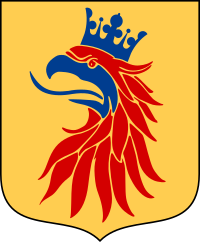Page 1 of 2
Prince Oscar of Sweden, Duke of Skåne (Scania)
Posted: 03 Mar 2016, 11:28
by Chris Green
Crown Princess Victoria gave birth to her second child yesterday evening. It has just been announced that he will be called Oscar Carl Olof and that he will be Duke of Skåne (Scania).
His arms will be promulgated later, but in accordance with royal tradition will include the arms of his duchy in Q3. So they will look very like those of his uncle the Duke of Värmland (see below), but with Skåne at Q3 in place of Värmland.

Skåne arms (which differ depending on whether the arms of the landskap (geographical county) or - unlikely - län (administrative county) are used):
landskap:

or län:

His arms will not be the same as the previous Dukes of Skåne, most recently his great great grandfather Crown Prince Gustaf Adolf (who became King Gustaf VI Adolf)

or Crown Prince Carl, later King Carl XV of Sweden and IV of Norway:

Note that neither of the previous Dukes of Skåne used the exact arms of the modern county.
Re: Prince Oscar of Sweden, Duke of Skåne (Scania)
Posted: 03 Mar 2016, 11:57
by Arthur Radburn
The arms of the lan, having a red field, would be better from a tincture point of view when placed against the gold cross, but the historical precedent of the earlier dukes using the landskap arms may carry more weight. At least, they seem unlikely to follow the earlier precedent of bending the cross out of shape to accommodate the Scanian arms.
Re: Prince Oscar of Sweden, Duke of Skåne (Scania)
Posted: 03 Mar 2016, 13:36
by Torsten Laneryd
I think they will use the coat of the landskap because every landskap in Sweden is entitled to a ducal crown. Every län has a royal crown as it administrates the state affairs in the geografical area of the län. The borders of the 21 län are not always the same as the borders of the 25 landskap though.
Re: Prince Oscar of Sweden, Duke of Skåne (Scania)
Posted: 03 Mar 2016, 13:57
by Torsten Laneryd
The crown on the griffins head is golden in the older achievements of Scanian dukes. It was changed to blue in 1939 according to the famous tinktur rule.
Re: Prince Oscar of Sweden, Duke of Skåne (Scania)
Posted: 03 Mar 2016, 22:19
by Marcus Karlsson
Yes most certainly the Arms of the Landskap of Skåne will be used in the Armorial Bearings of Prince Oscar. Following precedent from the Arms of other Dukes and Duchesses.
Re: Prince Oscar of Sweden, Duke of Skåne (Scania)
Posted: 06 Mar 2016, 02:53
by Michael F. McCartney
Maybe they will add a bordure (Azure?) To the lan arms?
Or fimbrate the cross, at least in that quarter?
Re: Prince Oscar of Sweden, Duke of Skåne (Scania)
Posted: 06 Mar 2016, 08:54
by Torsten Laneryd

As you can see, Prince Daniel has a fimbration. He is the father of Prince Oscar.
Re: Prince Oscar of Sweden, Duke of Skåne (Scania)
Posted: 06 Mar 2016, 10:30
by Chris Green
Torsten: Fimbriation is "having a narrow edging of a different tincture from the rest of the charge" (Boutell). There is no fimbriation in the Swedish royal arms (or those of any of the family members). The cross as usually illustrated is in effect a fillet cross paty, though reading the Swedish blazon it should be emblazoned as a cross paty (i.e. a cross of the normal width):
Stora riksvapnet utgörs av en blå huvudsköld, kvadrerad genom ett kors av guld med utböjda armar ....
(Literally: The greater royal arms consists of a blue shield quartered by a cross of gold with splayed arms ....)
Re: Prince Oscar of Sweden, Duke of Skåne (Scania)
Posted: 06 Mar 2016, 12:05
by Torsten Laneryd
Yes, a fimbration is not in the blazon. I just wanted to point out the blue narrow band between the field of Västergötlands landskapsvapen and the cross, that do not exist for exemple between Värmlands landskapsvapen and the cross in the arms above, although even there metal meets metal.
Re: Prince Oscar of Sweden, Duke of Skåne (Scania)
Posted: 06 Mar 2016, 12:47
by Chris Green
Ah, now I see what you mean. The artist has distinguished between the gold of the cross and the gold of the field in Q3. If he had followed the blazon slavishly he wouldn't I suppose have done that, but it was artistically necessary. It is an interesting example of how the Swedish rigid interpretation of the tincture "rule" cannot always be followed to the nth degree.
I have seen many examples of heraldic artists distinguishing for example between one charge and another, or a charge and a parti-coloured field by giving the overlying charge an outline, though it is usually black. My own gold martlets have such an outline, overlying as they do both blue and silver. But this is not the same as fimbriation.










